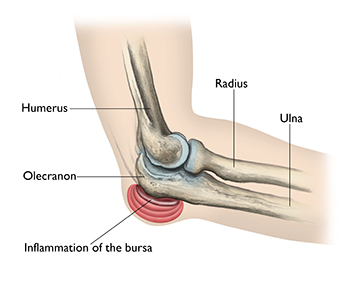Nonsurgical Treatment
If your doctor suspects that bursitis is due to an infection, he or she may recommend aspirating (removing the fluid from) the bursa with a needle. This is commonly performed as an office procedure. Fluid removal helps relieve symptoms and gives your doctor a sample that can be looked at in a laboratory to identify if any bacteria are present. This also lets your doctor know if a specific antibiotic is needed to fight the infection.
Your doctor may prescribe antibiotics before the exact type of infection is identified. This is done to prevent the infection from progressing. The antibiotic that your doctor prescribes at this point will treat a number of possible infections.
If the bursitis is not from an infection, there are several management options.
- Elbow pads. An elbow pad may be used to cushion your elbow.
- Activity changes. Avoid activities that cause direct pressure to your swollen elbow.
- Medications. Oral medications such as ibuprofen or other anti-inflammatories may be used to reduce swelling and relieve your symptoms.
If swelling and pain do not respond to these measures after 3 to 6 weeks, your doctor may recommend removing fluid from the bursa and injecting a corticosteroid medication into the bursa. The steroid medication is an anti-inflammatory drug that is stronger than the medication that can be taken by mouth. In some patients, corticosteroid injections work well to relieve pain and swelling. However, some patients do not have any relief of symptoms with corticosteroid injections.
Surgical Treatment
Surgery for an infected bursa. If the bursa is infected and it does not improve with antibiotics or by removing fluid from the elbow, surgery to remove the entire bursa may be needed. This surgery may be combined with further use of oral or intravenous antibiotics. The bursa usually grows back as a non-inflamed, normally functioning bursa over a period of several months.
Surgery for the noninfected bursa. If elbow bursitis is not a result of infection, surgery may still be recommended if nonsurgical treatments do not work. In this case, surgery to remove the bursa is usually performed as an outpatient procedure. The surgery does not disturb any muscle, ligament, or joint structures.
Recovery. Your doctor will apply a splint to your arm after the procedure to protect your skin. In most cases, casts or prolonged immobilization are not necessary.
Although formal physical therapy after surgery is not usually needed, your doctor will recommend specific exercises to improve your range of motion. These are typically permitted within a few days of the surgery.
Your skin should be well healed within 12 to 16 days after the surgery, and after 3 to 4 weeks, your doctor may allow you to fully use your elbow. Your elbow may need to be padded or protected for several months to prevent reinjury.
Visit Orthoinfo for more information.




 / 159 Reviews
/ 159 Reviews